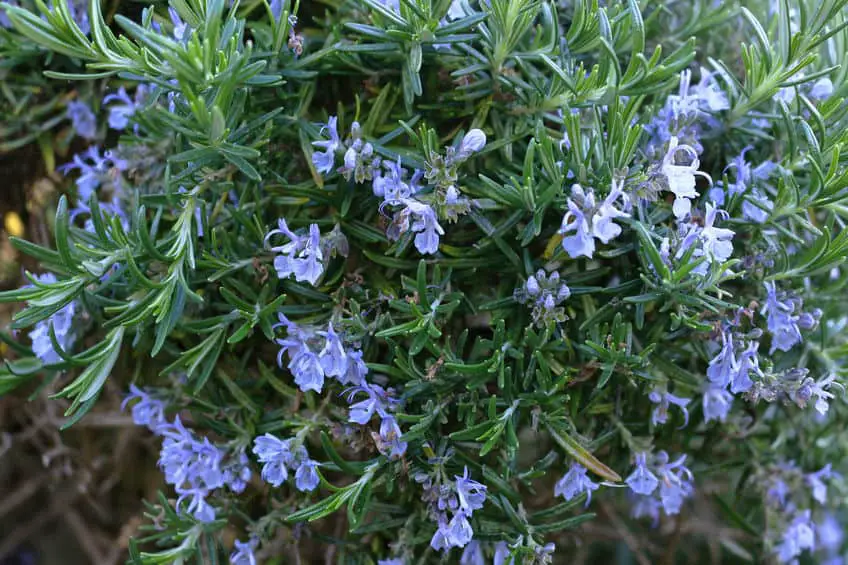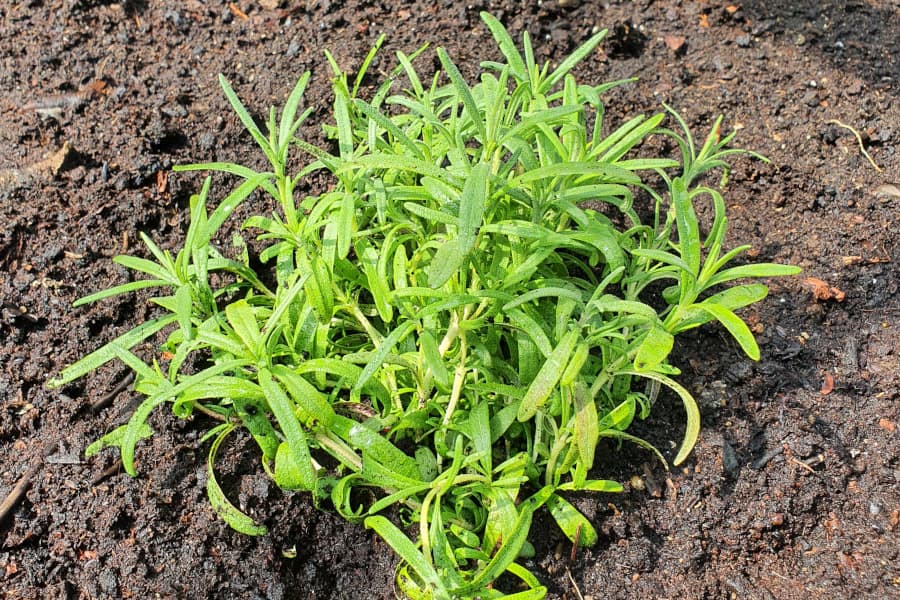This post contains affiliate links.
Rosemary plants produce some beautiful blue or purple flowers, but why do they appear? Why is your rosemary flowering, and should you do anything about it? I have done some research and answered both of those questions and more in this post.
There are two options if your rosemary is flowering. Removing the flowers will promote plant growth since the plant is no longer spending energy on flowering. Leaving the flowers will attract bees, which helps with pollination, ultimately leading to more flowers, fruit, and vegetables in your garden.
I personally usually just leave most of the flowers when my rosemary is flowering but that is not necessarily what you should do. Keep reading to find out whether removing the flowers or leaving them is the best way for you.

What Should You Do if Your Rosemary is Flowering?
When your rosemary plant is flowering, there are essentially two things you can do. You can let it flower, or you can stop it by pinching off the flowers or using pruning shears to remove them, and to be honest, both of these options are fine for the vast majority of people and won’t make much of a difference.
Whether or not you should remove the flowers depends on what you want from the plant, as it will affect how it behaves.
Here is what you should know to decide whether or not you should remove the flowers from your rosemary.
- Remove the flowers from your rosemary if:
- You want to maximize the growth and production of your plant as it extends the growing season slightly.
- You want to eat the flowers (they are great in salads or as garnish).
- You want your rosemary to become bushier (read more).
- Do NOT remove the flowers from your rosemary if:
- You want the plant to produce seeds.
- You want to attract bees to the garden (bees are your friends as they pollinate flowers).
- You like how they look.
- You are still not sure.
If you are going to remove the flowers, I recommend using clean, sharp pruning shears to avoid damaging the plant. I use and recommend these (link to Amazon).
If you are still not sure, then I recommend just letting your rosemary plant flower. Don’t do anything different than what you do when it is not flowering. Just keep taking some leaves whenever you need them, and you can even use the flowers for cooking if you want. They taste similar to the leaves but are milder.
As a general rule, herbs tend to change the taste and become more bitter once they flower but in my experience, this is not the case with rosemary. Or at least, the change in taste is so insignificant that it does not matter much to me.
If you allow your rosemary to flower, you might even be able to harvest seeds and grow them as new plants. If you’re interested in that, I have a guide on how to do it on this link.
What do I personally do when my rosemary is flowering?
I have had several rosemary plants and tried several things but now I always just let most of the flowers stay on my rosemary since I don’t feel the change in taste much and they are very nice to look at, plus that way I’m making the bees happy.
I used to leave all the flowers on my rosemary plant but for a while now, I have been picking some of them. I still leave most of the flowers on the plant to attract bees (and since they look nice) but I have found that they also taste great and can add a nice, colorful element to food. I especially like to use rosemary flowers in salads but more on what you can use rosemary flowers for later in this post.
Why Is Your Rosemary Flowering?
First of all, flowering is a great sign for rosemary. Flowering generally means that the rosemary plant is doing well, so no matter what, you should not worry if your rosemary begins to flower.
Rosemary plants flower to complete their reproductive cycle. Flowering is the process that ends with the production of seeds, which, from an evolutionary perspective, is the plant’s best way to ensure the survival of the species.
Generally speaking, rosemary plants usually only flower when they get enough sunlight, stay in good enough soil, have enough space, and otherwise have good enough conditions, so if your plant is flowering, you’re doing something right.
I have written another article where you can learn more about how to give your rosemary the best growing conditions. You can find that article on this link.
Rosemary usually begins to flower in the spring and keeps its flowers throughout the summer, although when I researched for this article, I found several people whose rosemary would be flowering at different times of the year. In my own experience, spring to summer fits pretty well with when my own rosemary plants usually flower.
What Time of the Year Does Rosemary Flower

Rosemary can grow all year if you take good care of it. It can even withstand some frost (read more). I love to be able to harvest rosemary at any time of the year, regardless if it is flowering or not.
As a general rule, rosemary flowers in the spring and early summer but since there are many varieties of rosemary, the exact flowering time can vary. Rosemary also requires full sun to flower which also makes the flowering time vary from region to region.
How to Make Your Rosemary Flower Faster
If you want to give your rosemary the best conditions possible and thereby promote flowering, there are some things you can do.
To make rosemary flower faster, do this:
- Grow rosemary in a warm, dry place.
- Give rosemary as much sunlight as possible.
- Grow rosemary in soil with good drainage.
Sunlight is especially important for rosemary to grow well and flower. You can read more about that on this link.
Can You Still Use Rosemary After It Flowers?
As a general rule, herbs tend to lose or change taste after they flower but in my experience, rosemary does not change its taste very much after it flowers, so I will happily harvest rosemary directly from the plant and eat it all year, regardless if it is flowering or not.
So, at least according to my personal experience (and my personal taste buds), there is no reason to worry when your rosemary is flowering, and certainly no reason to do anything drastic. Rosemary can still be used and still tastes excellent, even after it flowers.
What Can You Use Rosemary Flowers For?
There are actually a couple of things, you can use rosemary flowers for if you plan on removing them from your plant.
- First of all, rosemary flowers are edible. They have a very distinct, yet mild taste of rosemary. The flowers taste very similar to the leaves but they are quite a bit milder.
While I do let most of the flowers stay on my rosemary, I sometimes like to pick just a few of them and use them in salads, where they work as a tasty and beautiful white, pink, blue, or purple element.
- Rosemary flowers smell just like the plant which has a pine-like aroma. For this reason, people seem to like to use rosemary flowers for potpourri.
I have personally not used rosemary flowers for potpourri but I have used them in cooking, especially in salads many times and they are always a hit since they add a nice, colorful (and tasty) element to the cooking.
Does Rosemary Die After Flowering?
It can be a bit alarming when you first notice that your rosemary is flowering, but don’t worry, your plant is not about to die.
Rosemary does not die after flowering but instead continues to grow and produce new shoots once the flowering process is finished.
Many herbs are annuals that grow from seed, produce flowers and seeds, and then die all within the same growing season. Rosemary is different as it is usually grown as a perennial in most parts of the world, which means it lives for several years. You can read more about that here.

